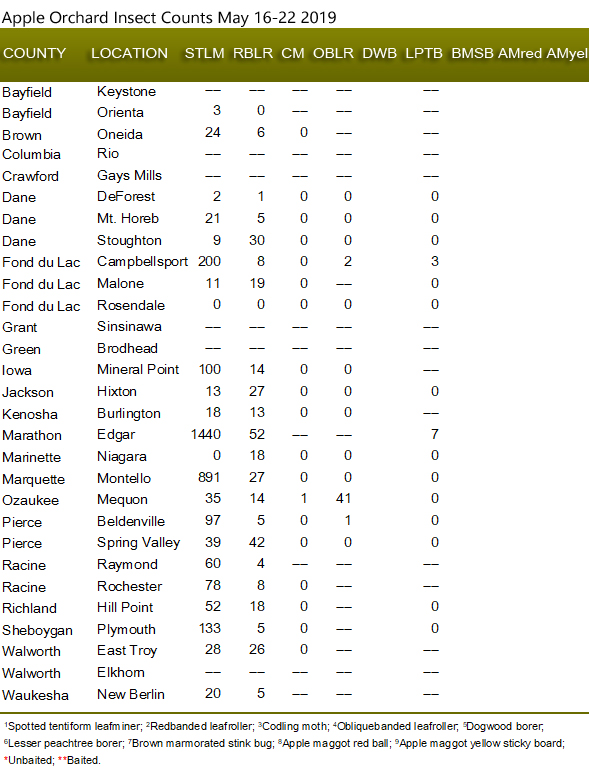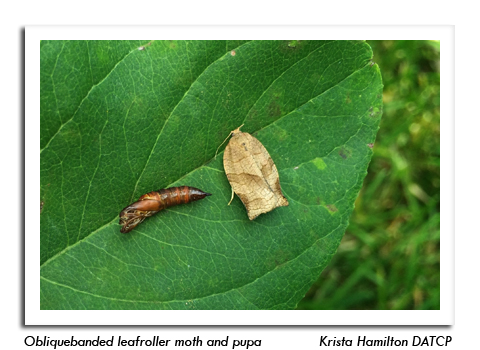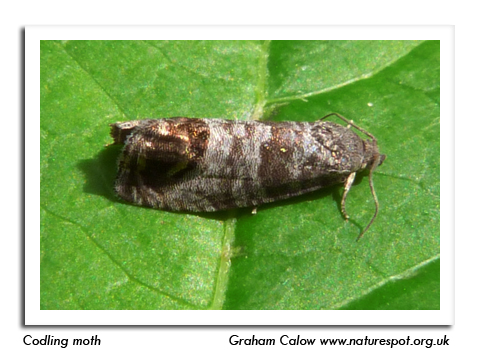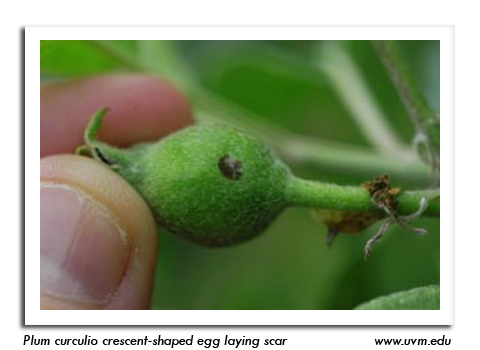
 |
|
|
Fruits
Volume 64 Number 4 Date 05/23/2019 OBLIQUEBANDED LEAFROLLER - The first flight began during the period of May 16-22, with moths reported from cooperating orchards in Fond du Lac, Ozaukee and Pierce counties. Larvae of various sizes and their characteristic folded leaves are still evident at many sites, signaling that moths should continue to emerge well into June. Checking terminals for small, first-generation OBLR larvae is advised 7-10 days after the first OBLRs are captured. Although there is no direct correlation between trap counts and larval populations, scouting is important since orchards that collect even low counts (< five moths per trap) can develop significant larval problems a few weeks after a flight has occurred. A population averaging three or more larvae per tree is considered economic. CODLING MOTH - Spring moth emergence is likely to begin over the weekend of May 25-26. Apple growers should continue checking traps daily until the biofix is established. In some years, determining this event is complicated by fluctuating temperatures that lead to inconsistent emergence. The biofix is either the date of the first sustained flight of moths captured multiple days in a row or when counts exceed the threshold of five moths per trap per week. This date marks the point at which to begin counting degree days (base 50F) to determine the optimal treatment window for first-generation larvae. PLUM CURCULIO - Adult migration into orchard edges is increasing, and oviposition scars will be detectable on developing fruitlets next week. Female weevils select early-sizing fruits 5 mm or larger for egg laying. Perimeter sprays can be used as an alternative to full cover sprays if PC injury is limited to the border rows. However, if oviposition scars are found beyond the first 4-5 rows of trees, a cover spray is the better approach. Organic growers have the option of applying Surround® WP (kaolin clay). Another control strategy is to leave untreated "trap rows" of early varieties that are treated with an insecticide such as PyGanic on a warm night when the weevils are most active. SPOTTED TENTIFORM LEAFMINER - Moth emergence has peaked in the southern two-thirds of the state and is now declining. Populations are transitioning to first-generation larvae. The scouting procedure for STLM is to sample 10 terminals and fruit spurs per tree on 2-3 trees per orchard block. Sapfeeder mines should be noticeable on the undersides of leaves. The economic threshold is one mine per 10 leaves. TARNISHED PLANT BUG - Nymphs can be anticipated by June. Strawberry plants beginning to bloom should be checked weekly for both adult and immature plant bugs. Control targeting the small first- and second-instar stages is most effective and can eliminate the need for a second treatment. The economic threshold for this insect in strawberries is four per 20 sweeps. REDBANDED LEAFROLLER - Counts of this pest also remained low from May 16-22. The first flight peaked 1-2 weeks ago in most orchards and numbers have been declining. The second flight should start by early to mid-June. Apple growers are reminded to replace pheromone lures for both RBLR and STLM in preparation for the second flights. OYSTERSHELL SCALE - Egg hatch and the onset of the first-generation nymph or "crawler" period is expected to begin next week in southern and western Wisconsin. The appearance of the dispersal stage indicates treatments should begin promptly. For smaller infestations in yards or on ornamental trees, the scale coverings and crawlers can be destroyed by scrubbing the bark with a mildly abrasive pad or sponge. Very heavily infested branches may need to be pruned. Activity by the mobile stage lasts only for 1-2 weeks before the crawlers settle onto branches and develop protective waxy covers. Apple growers in central and eastern Wisconsin should also begin scouting for crawlers in the week ahead. -- Krista Hamilton, DATCP Entomologist 




|
|
|